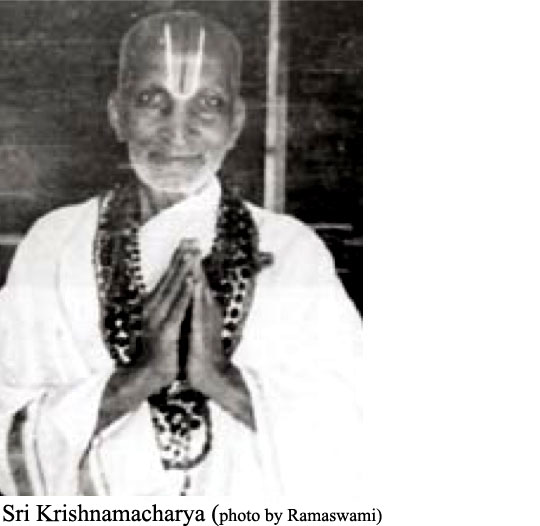Behind every ritual should be meditation. Below one can read a short excerpt from the article My Studies With Sri Krishnamacharya by Srivatsa Ramaswami which originally appeared in NAMARUPA magazine. It is a description of the care his teacher showed, both externally and within, in folding his palms to offer prayer (anjali-mudra). Sri Krishnamacharya, (1888-1989), taught many of the key figures in modern-day yoga, including B.K.S. Iyengar (founder of Iyengar Yoga), the late Sri K. Pattabhi Jois (the founder of Ashtanga Yoga), the late Indra Devi, T.K.V. Desikachar (his son), as well as the article’s author Srivatsa Ramaswami. One can read the entire article here.
Kaustubha das
“There would always be a Purva-shanti (beginning peace invocation), and following tradition, class would always end with a peace chant called Uttara-shanti, normally the surrender shloka to Lord Narayana found in Vishnu-sahasranama, and the forgiveness or ksamapana-stotra, if it was Vedic chanting class. The way my guru maintained anjali-mudra while saying the prayer was a point of study. He said that in this mudra the palms should be slightly cupped while keeping the hands together. There should be a hollow between the palms sufficient to hold an imaginary lotus or your heart in a gesture of loving offering to the dhyeya, the object of your meditation. The arms should be close to the body but not touching the body, and the folded hands, inclined by about thirty degrees, should be held in front of the heart or the sternum. With a straight back and head slightly bowed, Sri Krishnamacharya would be a dignified picture of peace and devotion.”
Related Articles: My Studies With Krishnamacharya

Comments
4 responses to “Sri Krishnamacharya’s Anjali-mudra”
I read the above article and have one doubt. I will appreciate if you can clarify it. The author talks about how Yoga is dualistic while Vedanta(both advaita and visitiadvaita) acknowledges that ultimate reality is one. At the same time he says anything which contradicts Yoga Sutra should be rejected. I don’t understand these statements together. What is relation between Vedanta and Yoga and what is belief of the author?Is the yoga described in sixth chapter of Gita Patanjali’s yoga?
I will appreciate if you can reply to my queries.
Just a short remark: in the second book of the Vedanta Sutra, there are criticisms of the yoga school because it does not accept that brahman is the ultimate cause of the world. It takes prakriti to be the ultimate cause, and the purushas are held to be a second kind of thing. So unlike most of Vedanta, even theistic Vedanta, which holds that reality is one, although it may be internally qualified in various ways, the yoga tradition is dualistic.
The Gita 6th chapter was written before the yoga-sutra, so it is not Patanjali’s yoga, though it it seems that some elements of it were taken up by Patanjali.
Then I dont understand why krsnamacarya says anything which contradicts Yoga Sutra should be rejected if it is contrary to Vedanta.
Another thing as Vedanta sutra is mentioned in B.G, you can argue that B.G came after Vedanta sutra.
And Vedanta Sutra has to come after Yoga Sutras so that there is commentary on the yoga school. This all is confusing especially when Vyasa himself wrote a commentary on yoga sutras as well. How to resolve all this?
Vivekeji,
Briefly: As I said above, you can see in the second chapter of Vedanta sutra, that there are arguments against other schools, including Samkhya and Yoga. This suggests that there are contradictions between some of the core tenets of each school, even if, on the whole, concepts from each school may often be imported to support the other. So, it suggests that a teacher may endorse the ultimate teachings of one school over another. And a great teacher like Sri Krishnamacarya may take portions from each and explain to his students what elements may be rejected if they contradict each other. The Six schools often disagree with each other in matters of fundamental metaphysical categories, the nature of the pramanas, etc.
Whether the Vyasa who commented on the Yoga-sutra is the same as the one who is spoken of as writing the sacred texts is doubtful.
Regarding the dating of the texts, I am not an expert, so I don’t want to claim too much. But generally, the Gita is held, by scholars and in the traditional sources to be dated earlier. The refrence in the Gita may not be to the Vedanta sutra as we have it (there were other sutras in currency than Badarayana’s). And the Vedanta-sutra may refer to Samkhya-yoga traditions without referring to the yoga-sutras as we have them either. The Yoga-sutras and traditional commentaries admit that there was an earlier tradition anyway, going back to Hiranyagarbha.
Take care.